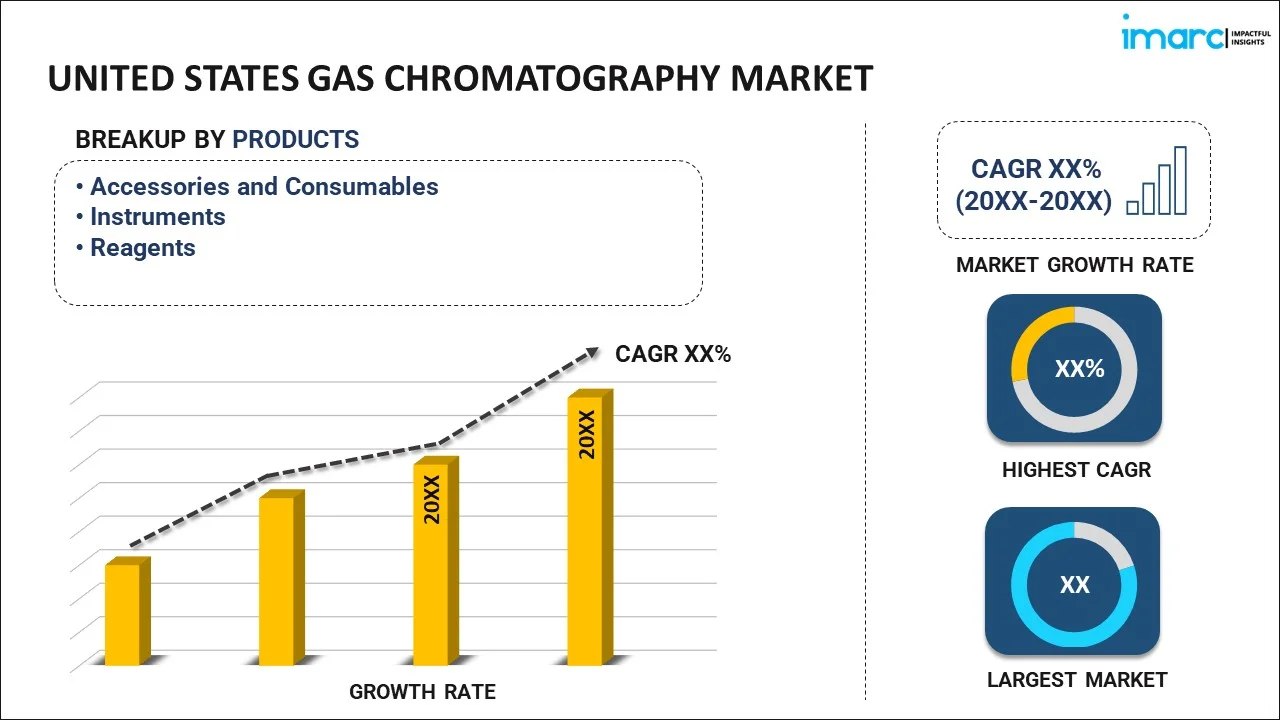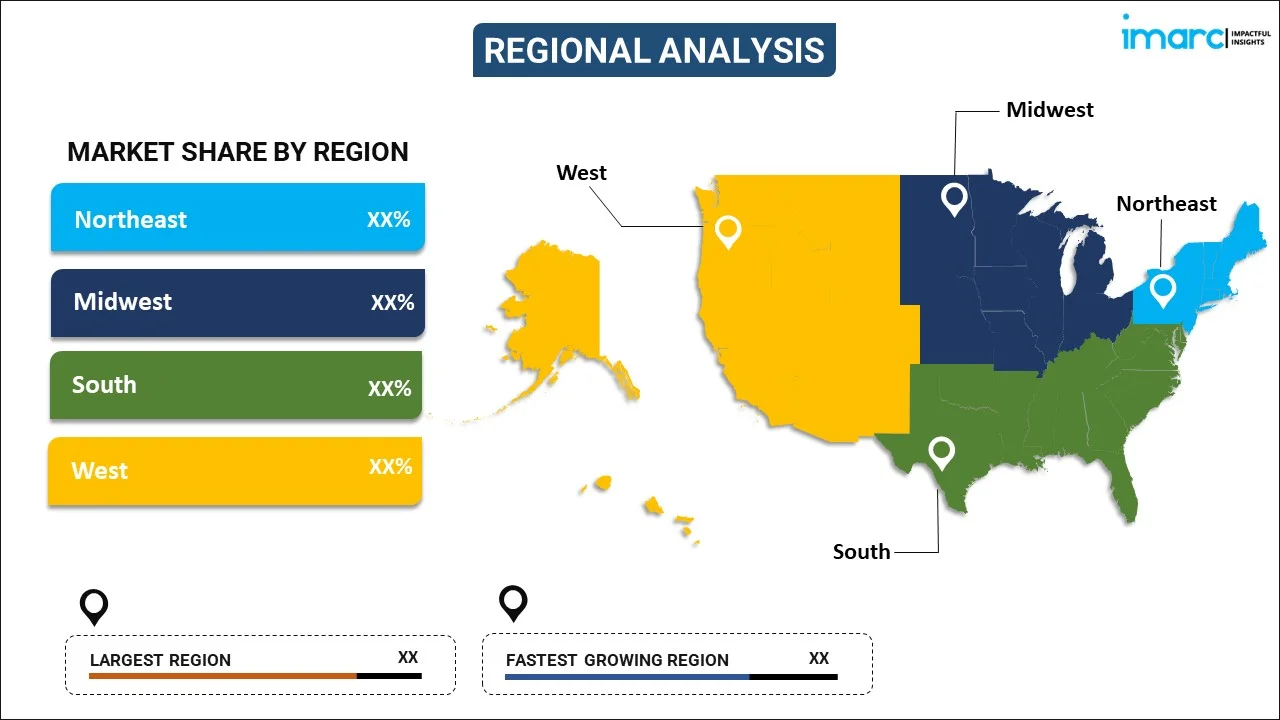
United States Gas Chromatography Market Report by Product (Accessories and Consumables, Instruments, Reagents), End Use Industry (Pharmaceutical, Oil and Gas, Food and Beverage, Agriculture, Environmental Biotechnology, and Others), and Region 2025-2033
Market Overview:
United States gas chromatography market size reached USD 877 Million in 2024. Looking forward, IMARC Group expects the market to reach USD 1,494.3 Million by 2033, exhibiting a growth rate (CAGR) of 6.1% during 2025-2033. Extensive R&D activities in the pharmaceuticals industry are primarily propelling the market growth across the country.
|
Report Attribute
|
Key Statistics
|
|---|---|
|
Base Year
|
2024 |
|
Forecast Years
|
2025-2033
|
|
Historical Years
|
2019-2024
|
| Market Size in 2024 | USD 877 Million |
| Market Forecast in 2033 | USD 1,494.3 Million |
| Market Growth Rate (2025-2033) | 6.1% |
United States Gas Chromatography Market Analysis:
- Major Market Drivers: The United States Gas Chromatography Market Growth is primarily driven by extensive R&D activities in the pharmaceutical industry, stringent regulatory requirements for drug quality control, increasing environmental monitoring needs, and growing food safety regulations requiring precise analytical testing capabilities across various industrial applications.
- Key Market Trends: Rising adoption of hyphenated techniques like GC-MS, increasing automation in analytical laboratories, growing demand for portable and miniaturized systems, and integration of AI-based data analysis tools are shaping the market dynamics and technological advancement trajectories.
- Market Challenges: High initial investment costs for advanced systems, requirement for skilled technical personnel, maintenance complexity of sophisticated instruments, and competition from alternative analytical techniques pose challenges to United States Gas Chromatography Market Analysis and widespread adoption across smaller laboratories and research facilities.
- Market Opportunities: Emerging applications in biotechnology and environmental analysis, expanding pharmaceutical research activities, growing demand for process optimization in oil and gas industries, and increasing focus on sustainability present significant growth opportunities for market expansion and technological innovation.
Gas chromatography (GC) is an analytical method employed to identify and separate compounds within chemical mixtures. This technique utilizes detectors like flame ionization detectors (FIDs) and thermal conductivity detectors (TCDs) to spot trace components, along with organic and inorganic compounds. An inert gas, such as helium, argon, hydrogen, or nitrogen, carries the volatile gaseous compounds (VOC) across various components, including the sample injector, flow controller, and detector, facilitating data acquisition and analysis. Gas chromatography, in contrast to traditional micro-extraction and electrophoresis separation methods, presents a more cost-effective and dependable alternative.
United States Gas Chromatography Market Trends:
Integration of AI and Advanced Data Analytics
The convergence of artificial intelligence and high-performance data analytics is transforming the United States gas chromatography marketplace, turning analytical methods into smart, self-optimizing systems. Contemporary GC instrumentation includes machine learning algorithms that can optimize separation conditions automatically, predict maintenance needs, and improve compound identification confidence. The technology allows laboratories to analyze larger sample volumes with enhanced consistency and less human intervention. Automated systems driven by AI can scrutinize sophisticated chromatograms, detect patterns that may go unnoticed for human analysts, and deliver predictive information for method development. The United States Gas Chromatography Market Growth greatly benefits from these breakthroughs because they resolve the demand for higher-throughput analysis in pharmaceutical research, environmental monitoring, and quality control uses. They also support remote monitoring and control functionality, so technicians are able to control a number of instruments at once while preserving analytical accuracy and reliability levels.
Miniaturization and Portable GC Systems
The creation of portable and miniaturized systems for gas chromatography is a major paradigm change in analytical chemistry to meet the emerging need for on-site analysis and field use. The miniature systems preserve analytical performance while providing unmatched mobility and lowered operational costs. Portable GC units are increasingly being applied in environmental monitoring, food safety analysis, and industrial process control where real-time analysis is extremely important. The United States Gas Chromatography Market Analysis indicates rising use of such systems in sectors that need swift decision-making through analytical outcomes. These miniaturized systems employ microfluidic technology, lower consumption of carrier gas, and battery operation to provide laboratory-grade outcomes in field environments. This phenomenon proves to be extremely useful for pharmaceutical firms running clinical trials, environmental authorities measuring air quality, and food manufacturers assuring product purity. The portability aspect removes sample transport time delays and offers instantaneous analytical feedback, greatly enhancing operational efficiency and response time.
Sustainable and Green Chromatography Practices
Environmental sustainability is becoming a priority in gas chromatography operations and is forcing the implementation of green chemistry principles and environmentally friendly analytical methodologies. New GC systems are now being developed with energy-efficient parts, lower consumption of carrier gas, and recyclable components to reduce environmental impact. The United States Gas Chromatography Market Share is now influenced more by laboratories trying to minimize their carbon footprint without compromising on analytical performance. Green chromatography efforts involve alternative carrier gas use, solvent reduction methods, and waste reduction methodologies. The use of lower power requirements, better thermal efficiency, and lower maintenance designs for systems is being promoted by manufacturers in response to sustainability objectives. The trend is applied in method development methodologies with analysts aiming to achieve shorter analysis time, lower operating temperature, and less sample preparation needs. Regulatory bodies and industry associations are encouraging these environmentally friendly practices, establishing market opportunities for green analytical solutions that satisfy both performance and environmental requirements.
United States Gas Chromatography Market Segmentation:
IMARC Group provides an analysis of the key trends in each segment of the market, along with forecasts at the country level for 2025-2033. Our report has categorized the market based on product and end use industry.
Product Insights:

To get more information on this market, Request Sample
- Accessories and Consumables
- Columns and Accessories
- Fittings and Tubing
- Auto-sampler Accessories
- Flow Management and Pressure Regulator Accessories
- Others
- Instruments
- Systems
- Auto-samplers
- Fraction Collectors
- Detectors
- Flame Ionization Detectors (FID)
- Thermal Conductivity Detectors (TCD)
- Mass Spectrometry Detectors
- Others
- Reagents
- Analytical Gas Chromatography Reagents
- Bioprocess Gas Chromatography Reagents
The report has provided a detailed breakup and analysis of the market based on the product. This includes accessories and consumables (columns and accessories, fittings and tubing, auto-sampler accessories, flow management and pressure regulator accessories, and others), instruments [systems, auto-samplers, fraction collectors, detectors (flame ionization detectors (FID), thermal conductivity detectors (TCD), mass spectrometry detectors, and others)], and reagents (analytical gas chromatography reagents and bioprocess gas chromatography reagents).
End Use Industry Insights:
- Pharmaceutical
- Oil and Gas
- Food and Beverage
- Agriculture
- Environmental Biotechnology
- Others
A detailed breakup and analysis of the market based on the end use industry have also been provided in the report. This includes pharmaceutical, oil and gas, food and beverage, agriculture, environmental biotechnology, and others.
Regional Insights:

- Northeast
- Midwest
- South
- West
The report has also provided a comprehensive analysis of all the major regional markets, which include the Northeast, Midwest, South, and West.
Competitive Landscape:
The market research report has also provided a comprehensive analysis of the competitive landscape in the market. Competitive analysis such as market structure, key player positioning, top winning strategies, competitive dashboard, and company evaluation quadrant has been covered in the report. Also, detailed profiles of all major companies have been provided.
Recent News and Development:
- In June 2025, PEAK Scientific unveiled Intura, its latest GC gas generation innovation, at ASMS 2025 in Baltimore. Designed to enhance productivity and analysis quality, Intura offers hydrogen, nitrogen, and zero air generators in a compact, energy-efficient design. Building on the Precision series, it delivers high-purity carrier and detector gases with improved flow flexibility, reduced footprint, lower power use, and innovations like a new CAT chamber, upgraded PSA dryer, and patented AirMax intake filter.
- In January 2025, Shimadzu launched seven advanced gas chromatography (GC) systems, including the compact Brevis GC-2050, targeting growing demand in green energy and sustainable practices. Featuring the world-first “ECO Idling Function”, these systems reduce power and gas consumption while enhancing efficiency and flexibility with improved detectors. This launch reinforces Shimadzu’s role as an innovator and total solution provider, supporting industries in precise gas analysis, carbon neutrality, and environmental compliance.
United States Gas Chromatography Market Report Coverage:
| Report Features | Details |
|---|---|
| Base Year of the Analysis | 2024 |
| Historical Period | 2019-2024 |
| Forecast Period | 2025-2033 |
| Units | Million USD |
| Scope of the Report | Exploration of Historical and Forecast Trends, Industry Catalysts and Challenges, Segment-Wise Historical and Predictive Market Assessment:
|
| Products Covered |
|
| End Use Industries Covered | Pharmaceutical, Oil and Gas, Food and Beverage, Agriculture, Environmental Biotechnology, Others |
| Regions Covered | Northeast, Midwest, South, West |
| Customization Scope | 10% Free Customization |
| Post-Sale Analyst Support | 10-12 Weeks |
| Delivery Format | PDF and Excel through Email (We can also provide the editable version of the report in PPT/Word format on special request) |
Key Benefits for Stakeholders:
- IMARC’s industry report offers a comprehensive quantitative analysis of various market segments, historical and current market trends, market forecasts, and dynamics of the United States gas chromatography market from 2019-2033.
- The research report provides the latest information on the market drivers, challenges, and opportunities in the United States gas chromatography market.
- Porter's five forces analysis assist stakeholders in assessing the impact of new entrants, competitive rivalry, supplier power, buyer power, and the threat of substitution. It helps stakeholders to analyze the level of competition within the United States gas chromatography industry and its attractiveness.
- A competitive landscape allows stakeholders to understand their competitive environment and provides an insight into the current positions of key players in the market.
Key Questions Answered in This Report
The gas chromatography market in the United States was valued at USD 877 Million in 2024.
The United States gas chromatography market is projected to exhibit a CAGR of 6.1% during 2025-2033, reaching a value of USD 1,494.3 Million by 2033.
The market is primarily driven by extensive R&D activities in the pharmaceuticals industry, stringent regulatory requirements for drug quality control, increasing environmental monitoring needs, growing food safety regulations, and technological advancements in analytical instrumentation that enhance precision and efficiency.
Need more help?
- Speak to our experienced analysts for insights on the current market scenarios.
- Include additional segments and countries to customize the report as per your requirement.
- Gain an unparalleled competitive advantage in your domain by understanding how to utilize the report and positively impacting your operations and revenue.
- For further assistance, please connect with our analysts.
 Request Customization
Request Customization
 Speak to an Analyst
Speak to an Analyst
 Request Brochure
Request Brochure
 Inquire Before Buying
Inquire Before Buying




.webp)




.webp)












